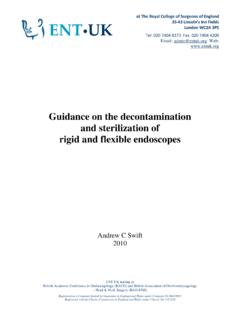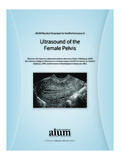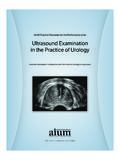Transcription of The disinfection requirements in ultrasound - Tristel
1 Page 1 of 4 Transvaginal and transrectal ultrasound probes are semi-critical medical devices and as such require high-level disinfection as a minimum. As the focus tends to be on endo-cavity probes, the rest of the ultrasound station is often forgotten. This paper will review the different requirements associated with the use of ultrasound stations and will focus more specifically on the disinfection requirements of skin surface probes, probe holders, cables, monitors and keyboards. ultrasound stations ultrasound stations are used when performing specific routine check-ups as well as when diagnosing and following up on a wide variety of symptoms, diseases and conditions.
2 ultrasound stations are usually quite big and include several types of equipment: a computer, a screen, a keyboard and one or several ultrasound transducers. The transducers, also referred to as probes, are small devices connected to the computer by a cable. During the diagnosis, the transducer sends out high frequency sound waves through the body of the patient and listens for the returning echoes. The waves are immediately measured by the computer which can re-create a real-time picture on the screen of the The key advantage of using an ultrasound station is that internal organs can be examined without making contact with sterile tissues.
3 Transducers are either applied on the skin of the patient or inserted through a natural opening of the human body ( vagina). The family of transducers applied on skin is referred to as skin surface probes. It includes instruments such as transabdominal probes. These are used to monitor the main organs of the abdomen which include the gallbladder, the kidneys, the liver, the pancreas and the The family of transducers inserted through natural openings of the human body is called endo-cavity probes. It includes transvaginal and transrectal probes. These are respectively used to examine organs of the female reproductive and male pelvic ,4 ultrasound stations can be personalised based on the transducers needed by the ultrasound department.
4 Some will require a variety of skin surface probes for general diagnoses. 1 General ultrasound 2 National Library of Medicine Medline Plus Abdominal ultrasound 3 National Library of Medicine Medline Plus Transvaginal ultrasound Others have a need for transabdominal and transvaginal probes for women s health or transrectal probes for men s health. disinfection is required at the end of each procedure. However, it is likely to differ from one probe to another. The decontamination process and levels of disinfection associated with ultrasound stations have to be adapted depending on the transducers used.
5 Healthcare professionals have to pay particular attention to the conditions under which the diagnosis is taking place to understand the levels of disinfection required. The disinfection requirements ultrasound stations can be divided into three categories: 1) Endo-cavity probes, 2) Skin surface probes, 3) Other equipment. The latter includes monitors, keyboards, probe holders and cables. Endo-cavity probes Although endo-cavity probes only enter through natural openings of the human body, they do come into contact with non-intact skin and mucous membranes.
6 This classifies them as semi-critical and implies the use of a high-level disinfectant. Endo-cavity probes are known to be a concern in ultrasound departments due to the high-risk of transmitting Sexually Transmitted Infections (STDs) between patients. Human Papilloma Virus (HPV) is a particular concern as it can cause cervical cancer. It is estimated that 75 to 80% of females and males are affected by HPV at some point in their lives. In order to lower the risk to a minimum, it is common practice to cover endo-cavity probes with a disposable sheath.
7 This does not change the semi-critical classification of endo-cavity probes nor the need to high-level disinfect them. Leakage rates associated with disposable sheaths do not make them a reliable prevention tool on their ,6 Skin surface probes As implied by their name, skin surface probes come into contact with intact skin in most cases. They are usually classified as non-critical items and undergo low or intermediate-level disinfection . 4 Emedicinehealth Pelvic ultrasound 5 Centers for Disease Control and Prevention Guideline for disinfection and Sterilization in Helathcare Facilities, 2008 6 The Clean Academy HPV: Do you know the facts?
8 October 2013 August 2016 The disinfection requirements in ultrasound Page 2 of 4 However, based on the circumstances under which the diagnosis takes place, the classification of the probe might have to be upgraded to semi-critical. A patient suffering from injuries or wounds might leave a certain amount of body fluids on the device. In other cases, skin-surface probes are needed during needle biopsies. This implies the use of a skin-surface probe to guide the needle to the internal part of the body where tissues have to be removed. The probability of the probe coming into contact with blood, mucous membranes or other body fluids is high in these ,8 A study recently conducted in Australia found more contamination on a selected sample of transabdominal probes than on transvaginal When using skin surface probes, high-level disinfection should always be considered, especially if body fluids are present during the diagnosis.
9 Other equipment Monitors, keyboards, probe holders and cables all classify as non-critical items. However, some studies have demonstrated that this equipment can have more contamination than ultrasound probes. This can be explained by: Poor decontamination practices: Probes are usually disinfected between each diagnosis. However, monitors, keyboards, probe holders and cables rarely touch the patient and can be 7 Emergency department ultrasound probe infection control: challenges and solution Hamid Shokoohi, Paige Armstrong, Ryan Tansek January 2015 8 NHS Biopsy 9 Australasian Society for ultrasound in Medicine Potential risks associated with an ultrasound examination.
10 A microbial perspective 2015 10 An investigation of the microbiological contamination of ultrasound equipment Sykes A, Appleby M, Perry J, and Gould K British Journal of Infection Control Aug 2006, Practitioner contact: Although patients do not necessarily come into contact with this equipment, practitioners do. Cross-contamination can occur from equipment to ultrasound gel: Without the use of gel, ultrasound waves can have difficulties travelling through the air and dry skin. ultrasound gel is used as a conductor to enable wave transmissions through the body of the patient.











